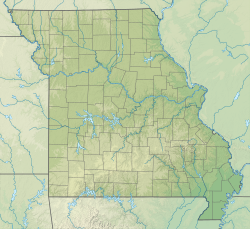| Kimmswick Limestone | |
|---|---|
| Stratigraphic range: Sandbian-Katian (Trentonian-Shermanian) ~ | |
 Fossil from the Kimmswick Limestone (Missouri) | |
| Type | Formation |
| Underlies | Cape Limestone, Maquoketa Group [1] or the Fernvale Limestone in Arkansas [2] |
| Overlies | Decorah Shale [1] or Plattin Limestone [2] |
| Lithology | |
| Primary | Limestone |
| Other | Sandstone, dolomite [2] |
| Location | |
| Coordinates | 39°12′N90°48′W / 39.2°N 90.8°W |
| Approximate paleocoordinates | 23°06′S66°00′W / 23.1°S 66.0°W |
| Region | Arkansas, Illinois, Missouri |
| Country | United States |
| Type section | |
| Named for | Kimmswick, Jefferson County, Missouri [3] |
| Named by | Edward Oscar Ulrich |
| Year defined | 1904 [1] |
The Kimmswick Limestone is an Ordovician geologic formation in Arkansas, Illinois and Missouri. Fossils occurring in the Kimmswick include corals, bryozoans, brachiopods, conodonts, [4] trilobites, crinoids and mollusks. [2]

